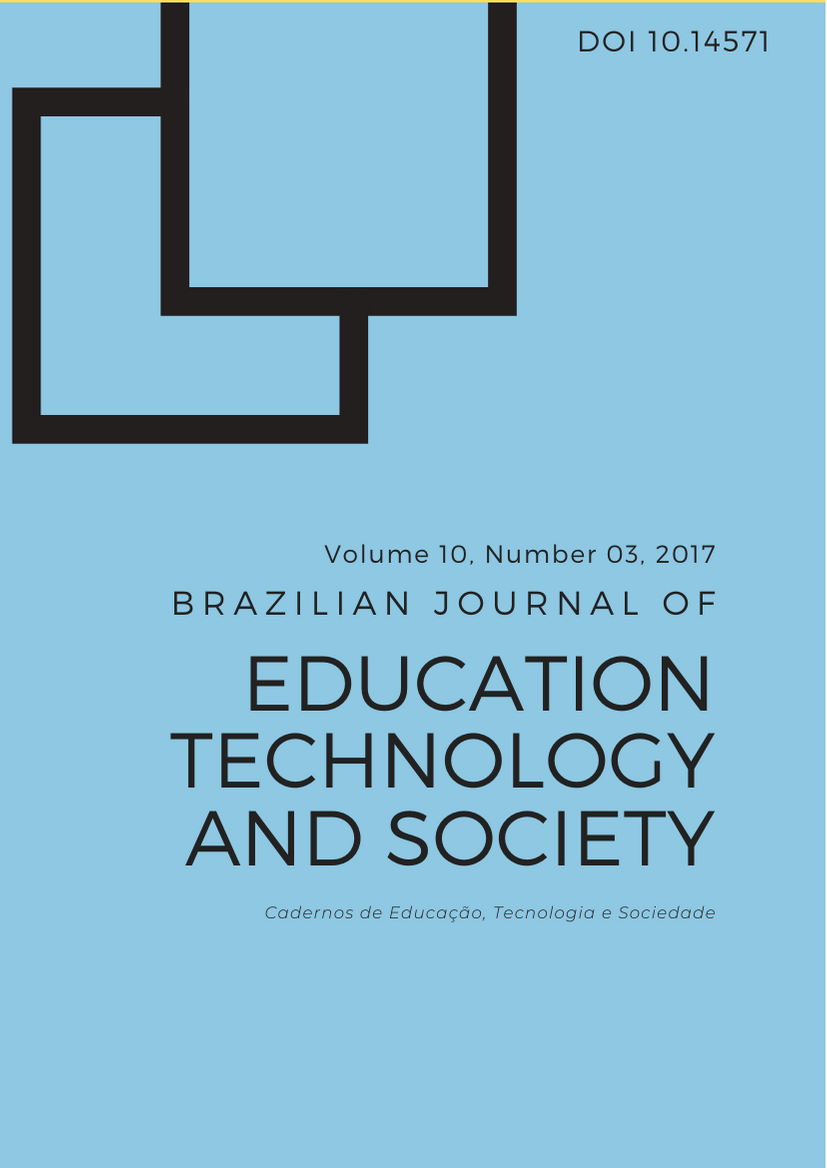AVALIAÇÃO DE UM AMBIENTE VIRTUAL DE APRENDIZAGEM NO DESENVOLVIMENTO DE COMPETÊNCIAS EM VINIFICAÇÃO POR APRENDIZES
DOI:
https://doi.org/10.14571/cets.v10.n3.257-264Resumo
Este trabalho é um estudo de caso que descreve e avalia um ambiente virtual de aprendizagem (AVA) com trabalhadores sazonais sem experiência (aprendizes). O AVA contém cenários 3D e 2D de uma vinÃcola moderna, com animação e simulação de sete processos de vinificação, com base nos Padrões Nacionais de Competência de Trabalho (WC) do Chile. O objetivo deste estudo foi avaliar o WC da vinificação desenvolvido pelos aprendizes neste AVA. Os WCs desenvolvidos pelos aprendizes foram verificados em campo por um especialista em três vinÃcolas diferentes. Além disso, elementos do WC como a rastreabilidade, segurança do trabalho e higiene foram avaliados por pesquisas. Os aprendizes apresentaram um desempenho positivo ao interagir com o equipamento da adega real, após o treinamento com o AVA. A importância deste estudo é a análise de um novo AVA baseado em uma vinÃcola e um processo de vinificação que possa se tornar uma eficiente ferramenta de aprendizagem para o desenvolvimento de competências de trabalho para os aprendizes.Referências
ALFARO, J.; RÁBADE, L. 2009. Traceability as a strategic tool to improve inventory management: A case study in the food industry. Int. J. Production Economics 118, 104–110.
AL-HUSSEIN, M., NIAZM, M. A., YU, H., KIM, H. (2006). Integrating 3D visualization and simulation for tower crane operations on construction sites. Automation in Construction, 15: 554-562.
AZAM, MD & BRAUCHLE, PE. 2003. A Study of supervisor and
employee perceptions of work attitudes in information age manufacturing industries. The Journal of Vocational Education Research 28(3), 85-216.
BISSON, L., WATERHOUSE, A.L., EBELER, S.E., WALKER, M.A., LAPSLEY, J.T. (2002). The present and future of the international wine industry. Nature 418, 696-699.
BITWINE (2016). Vinificación Virtual, Chile. Retrieved dic 2014 from http://www.bitwine.cl
BRAVO, I. (2013). Evaluación de BITWINE en instituciones técnico - profesional de nivel superior y operarios de bodegas de vino (tesis de pregrado). Universidad Católica del Maule, Chile.
BROUGH J.E., SCHWARTZ, M., GUPTA, S.K., ANAND, D.K., KAVETSKY R., PETTERSEN R. (2007). Towards the development of a virtual environment-based training system for mechanical assembly operations. Virtual Reality 11, 189–206.
BURKE, M. J., SARPY, S. A., TESLUK, P. E., SMITH-CROWE, K. (2002). General safety performance: A test of a grounded theoretical model. Personnel Psychology, 55, 429 – 457.
CHENG, W., WANG, S. (2011). Applying a 3D virtual learning environment to facilitate student’s application ability – The case of marketing. Computers and Human Behavior, 27, 576-584.
CHILEVALORA (2016). Comisión Sistema Nacional de Certificación de Competencias laborales, Chile. Retrieved May 2014 from http://www.CHILEVALORA.cl/index.php/documents/documentos-cl-top
CONICYT (2016). Consejo Nacional de Ciencia y TecnologÃa del Gobierno de Chile. Retrieved Jun 2014 from http://www.conicyt.cl
CORNEJO, M., CUBILLOS, N. (2015). Inserción y evaluación del simulador BITWINE en establecimientos educacionales de la Región del Maule (undergraduate thesis). Universidad Católica del Maule, Chile.
HARRIS, K.J., 1995. Training technology in the hospitality industry: a matter of effectiveness and efficiency. International Journal of Contemporary Hospitality Management 7(6), 24–29.
MCGEHEE, W.; THAYER, PW. (1961). Training in business and industry. Oxford, England: Wiley
EGANA, MB, RAATSA, MM, GRUBBA, SM., EVESB, A., LUMBERSB, ML, DEANA, MS, ADAMS, MR. (2007). A review of food safety and food hygiene training studies in the commercial sector. Food Control 18(10), 1180–1190
PLOG, BA. (2002). Fundamentals of industrial hygiene. 5° Ed. USA: National Safety Council
RICHARDS, D., TAYLOR, M. (2015). A Comparison of learning gains when using a 2D simulation tool versus a 3D virtual world: An experiment to find the right representation involving the Marginal Value Theorem. Computers & Education, 86, 157–171
RUTTEN, N., VAN JOOLINGEN, W.R., VAN DER VEEN, J.T. (2012). The learning effects of computer simulations in science education. Computers & Education 58(1), 136-153
SÁ, A., ZACHMANN. G. (1999). “Virtual reality as a tool for verification of assembly and maintenance processesâ€. Computer Graphics Journal, 23(3), 389-403.
SECONDLIFE (2016). Retrieved may 2016 from http://www.SECONDLIFE.com
SMITH-CROWE, K., BURKE, M. J., & LANDIS, R. S. (2003). Organizational climate as a moderator of safety knowledge–safety performance relationships. Journal of Organizational Behavior, 24, 861– 876.
TAM, E.K., BADRA F., MARCEAU R.J. MARIN M.A. (1999). A Web-based virtual environment for operator training [for power systems]â€. IEEE Transactions on Power Systems, 14(3), 802-808.
UNITY (2014). Retrieved may 2016 from http://www.unity3d.com
YE, N., BANERJEE, P., BANERJEE, A., DECH, F. (1999). A comparative study of assembly planning in traditional and virtual environmentsâ€. IEEE Transactions on System, Man, and Cybernetics-Part C: Applications and Reviews. 29(4), 546-555.
WEBSTER DICTIONARY (2016). Retrieved may 2016 from http://www.webster-dictionary.net/definition/Trine
WINTERTON, J, DELAMARE - LE DEIST, F., STRINGFELLOW, E. (2006). Typology of knowledge, skills and competences: clarification of the concept and prototype. CEDEFOP Reference series 64, Luxembourg: Office for Official Publications of the European Communities
WORLD HEATH ORGANIZATION. (2008). Global strategy on occupational health for all: The way to health at work. Retrieved in june 2016 from http://www.who.int/occupational_health/en/
ZHOU, J., LEE, I., THOMAS, B., MENASSA, R., FARRANT. A. SANSOME, A. (2012). In-Situ Support for Automotive Manufacturing Using Spatial Aumented Reality. The International Journal of Virtual Reality, 11(1), 33-41

